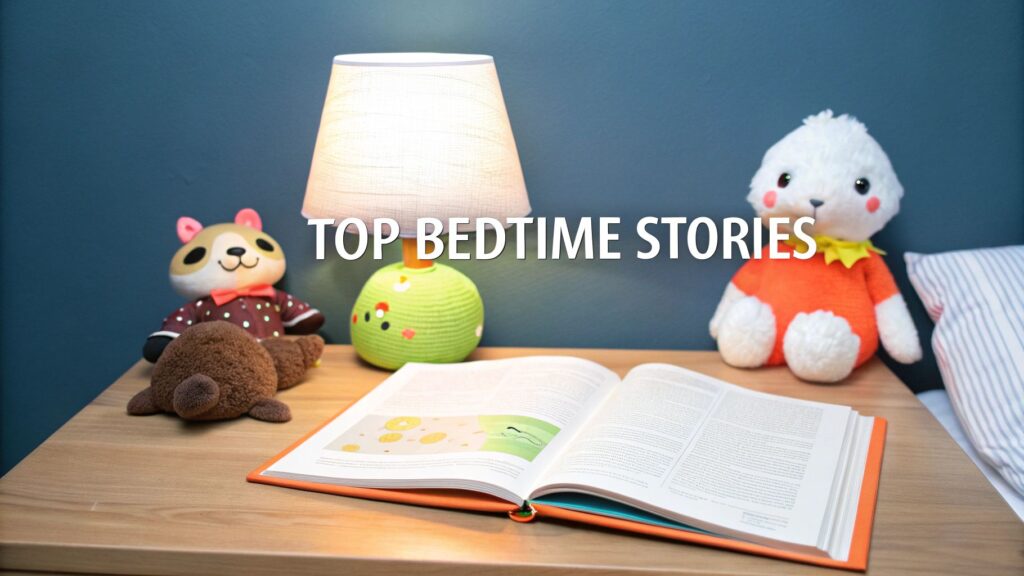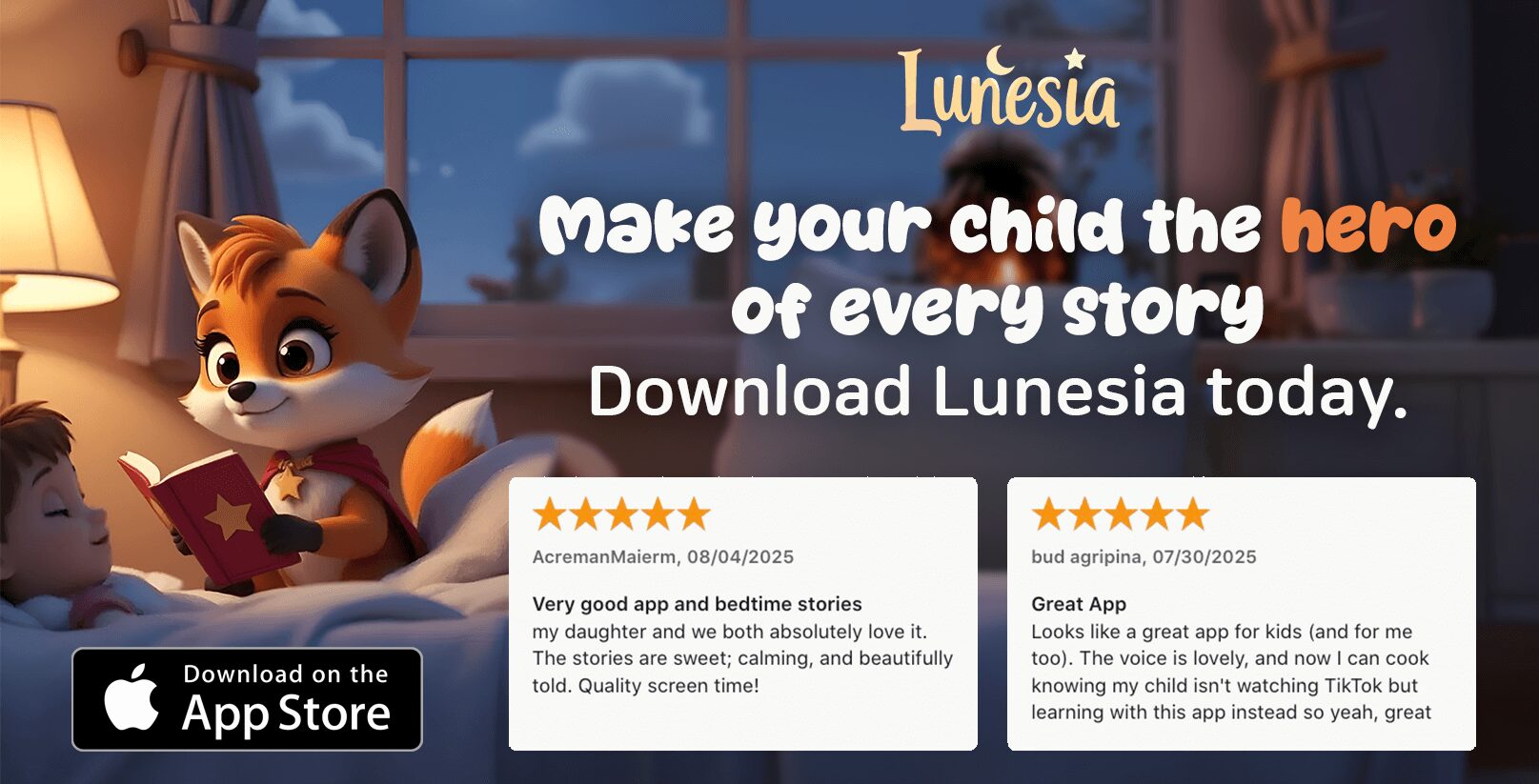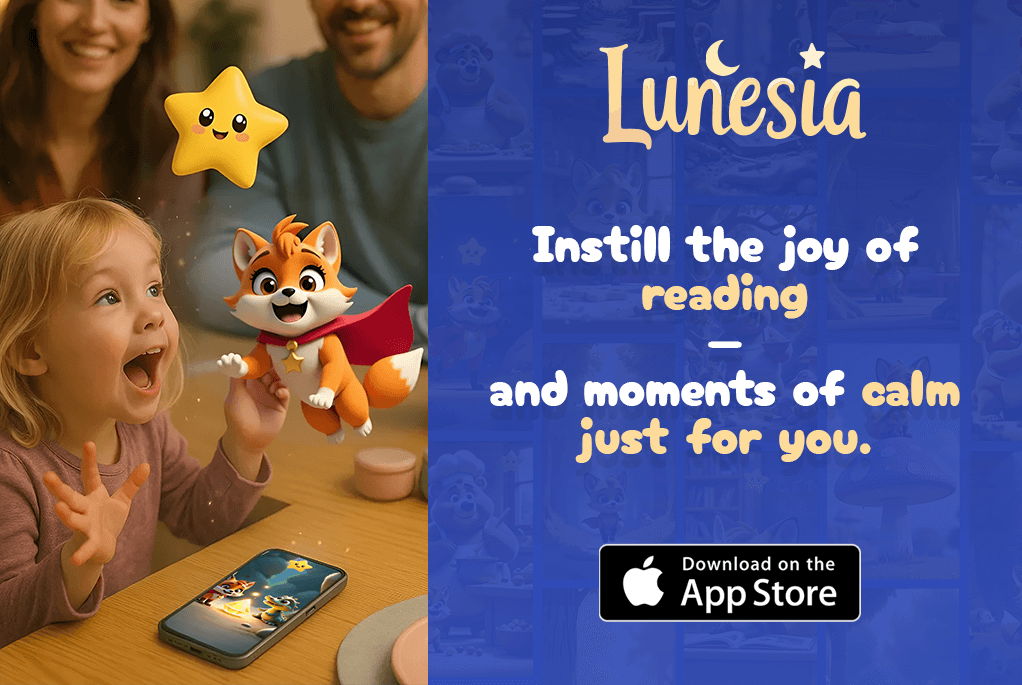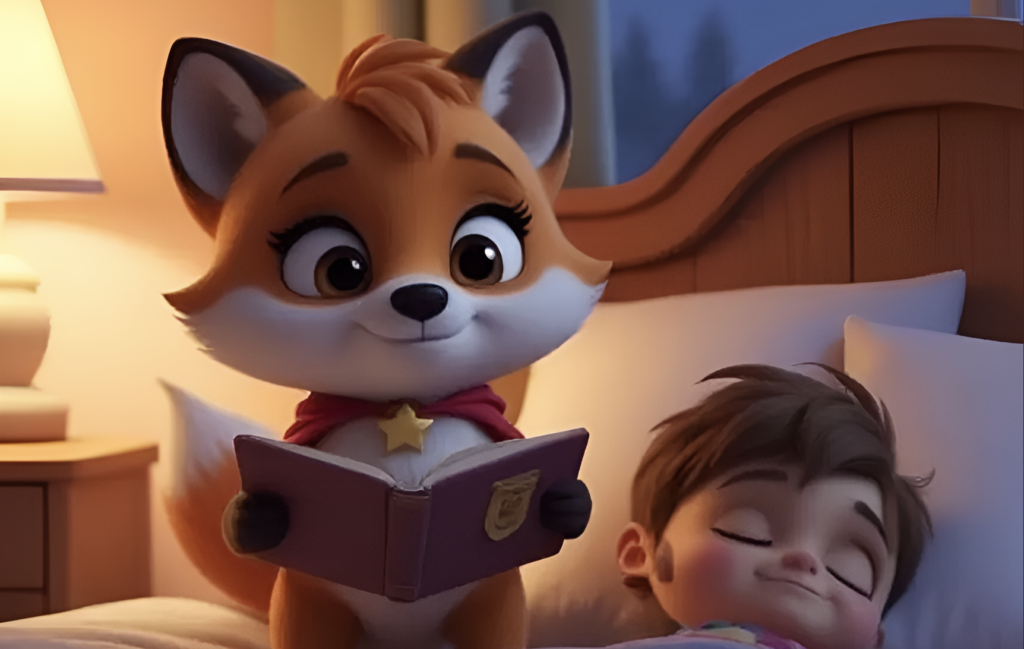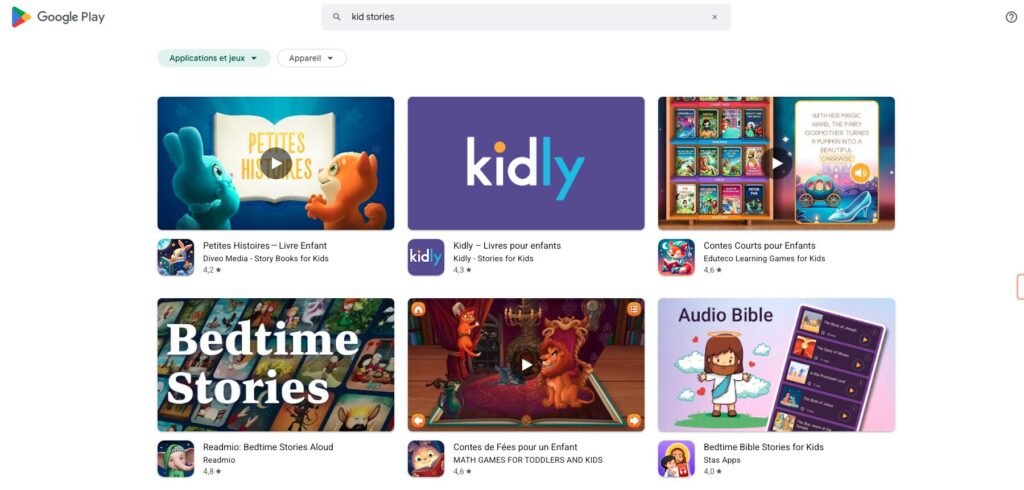You know the scene: the lights are low, the pajamas are on, but your kindergartner’s energy is still sky-high. You’ve tried everything, but winding down feels like an impossible nightly negotiation. What if the secret isn't just any story, but the right one? The one that doesn't just lull them to sleep, but also calms their anxieties, sparks their imagination, and deepens your bond.
Have you ever wondered what separates a good story from a truly transformative one? This isn’t just another list of classic books. We’re diving into a curated collection of the best bedtime stories for kindergartners and exploring why they work. I’ll show you how to turn these tales into interactive adventures that build emotional resilience and problem-solving skills. More than that, what if storytime could become so engaging that your child leads their own adventure, making choices that teach kindness and courage? That's the magic we're unlocking tonight.
Beyond the stories, ensuring the right sleep environment with elements like blackout shades for perfect light control can significantly improve the experience. But the core magic lies in the narrative. Did you know a consistent reading routine can boost a child's language development by as much as 30%? This guide will help you turn that potential into reality, transforming bedtime from a stressful chore into a cherished ritual of growth and connection.
1. Goodnight Moon
A true classic for a reason, Goodnight Moon by Margaret Wise Brown is more than just a story; it's a powerful sleep-inducing ritual. The book guides a young bunny through a gentle process of saying goodnight to every object in his "great green room." This simple, repetitive narrative creates a predictable and calming rhythm, signaling to a kindergartner's active mind that it's time to wind down.
The genius lies in its simplicity. As the bunny says goodnight to the kittens, the mittens, and the moon, your child is subconsciously invited to do the same, mentally preparing for sleep.
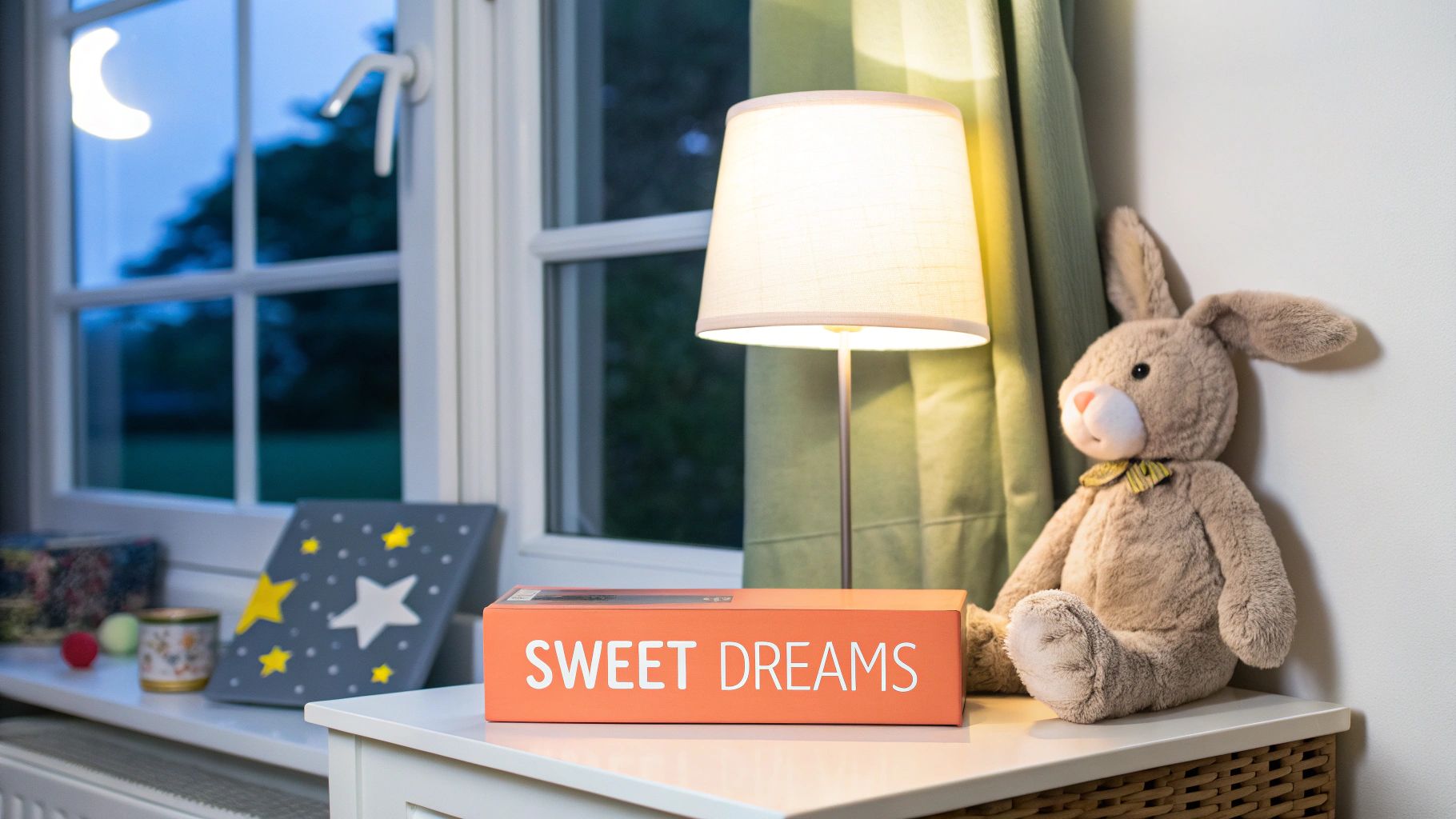
Making the Magic Work for You
Ever wondered how to turn this classic book into an even more effective sleep tool? The key is to make the experience multi-sensory and part of an unshakable routine.
- Vocal Cadence: Start reading in a normal, soft voice. As the bunny says goodnight to more items, gradually lower your volume to a whisper by the final pages. This auditory cue is incredibly effective at promoting calm.
- Light Dimming: Pair your reading with the room's lighting. Begin with a soft lamp on, and slowly dim the lights as you progress through the book, so the room is nearly dark by the time you read "Goodnight nobody."
- Interactive Whispers: Encourage your child to join in by whispering their own "goodnights" to items in their room—the stuffed bear, the toy truck, the window. This transforms them from a passive listener into an active participant in their own sleep routine.
By establishing a consistent ritual, you are giving your child a sense of security and control over their bedtime environment, which is fundamental to overcoming bedtime anxieties.
This book is a perfect example of how a simple narrative structure can significantly impact a child's sleep quality. Consistent routines like this are proven to help regulate a child's internal clock. If you’re interested in exploring how narrative elements influence rest, you can learn more about the science of bedtime stories and sleep quality. It provides fantastic insights into why stories are so crucial for a peaceful night.
2. Where the Wild Things Are
Maurice Sendak's Caldecott Medal-winning classic, Where the Wild Things Are, is a masterpiece for navigating the complex world of a kindergartner's emotions. We've all seen those post-dinner meltdowns, right? The story follows a mischievous boy named Max, who, after being sent to his room, sails away to an island of "wild things." It provides a safe, imaginative space for children to explore big feelings like anger and frustration, ultimately ending with the comforting reassurance of returning home to unconditional love.
This book validates a child's inner turmoil, showing them that even after a "wild rumpus," there is always a place of safety and a warm supper waiting. It’s a powerful tool for processing the difficult moments that can make bedtime a challenge.
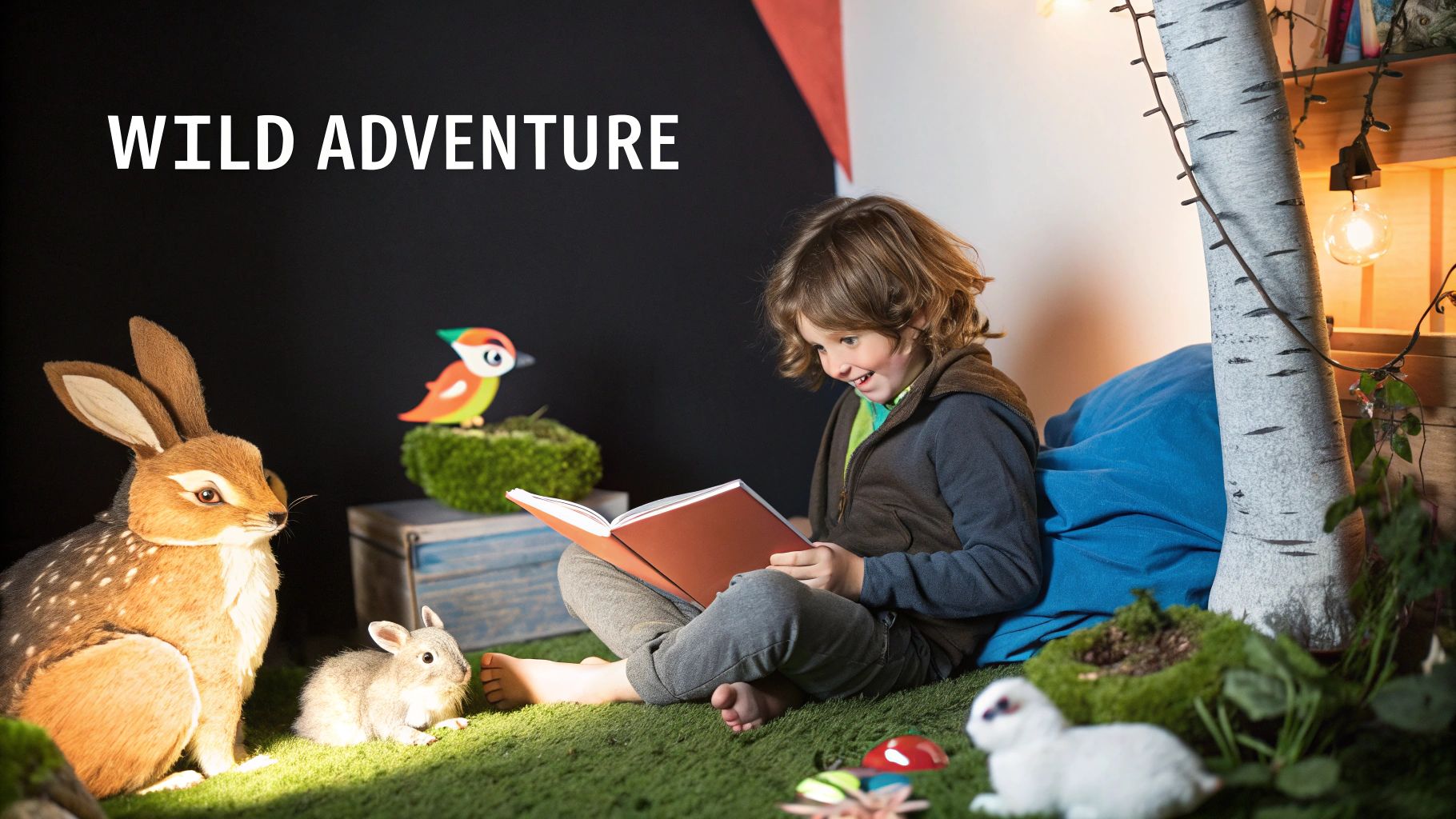
Making the Magic Work for You
Ever wonder how to use this adventure to tame your own little "wild thing" at bedtime? The secret is to use the story as a bridge to discuss and manage their feelings from the day.
- Feelings Check-In: Before reading, ask about their day. "Did anything make you feel like starting a 'wild rumpus' today? Like when your brother took your toy?" This opens a dialogue, helping them label their emotions just as Max does through his actions.
- Voice Acting Fun: Give each Wild Thing a unique, silly, or gruff voice. Encourage your child to roar along with you. This playful release of energy can be incredibly cathartic before settling down.
- Focus on the Return: Emphasize the final pages where Max sails home to find his supper "still hot." This powerfully reinforces the theme of security and love, a perfect anchor to end the day on.
By exploring big emotions within a story, you teach your child that feelings are manageable and that home is always a safe harbor. This is a foundational step in building emotional resilience.
This story is one of the best bedtime stories for kindergartners who have had a tough day or struggle with big feelings. It channels their energy constructively, reassuring them that they are loved no matter what. For children who thrive on making choices and seeing consequences in a safe space, interactive story apps like Lunesia offer adventures where they become the hero. In these stories, they make decisions that build real-world problem-solving skills and empathy, all while feeling empowered.
3. The Going to Bed Book
Sandra Boynton's The Going to Bed Book turns the nightly routine into a playful and rhythmic adventure. This delightful book follows a group of silly animals on a boat as they get ready for bed: brushing teeth, scrubbing in the tub, and even doing some last-minute exercises. Its rhyming, sing-song text is irresistibly catchy, transforming dreaded bedtime chores into fun, familiar steps.
For a kindergartner, this isn't just a story; it's a visual checklist that mirrors their own evening routine. The cheerful illustrations and simple, repetitive narrative demystify the process of winding down, making it less of a struggle and more of a game.
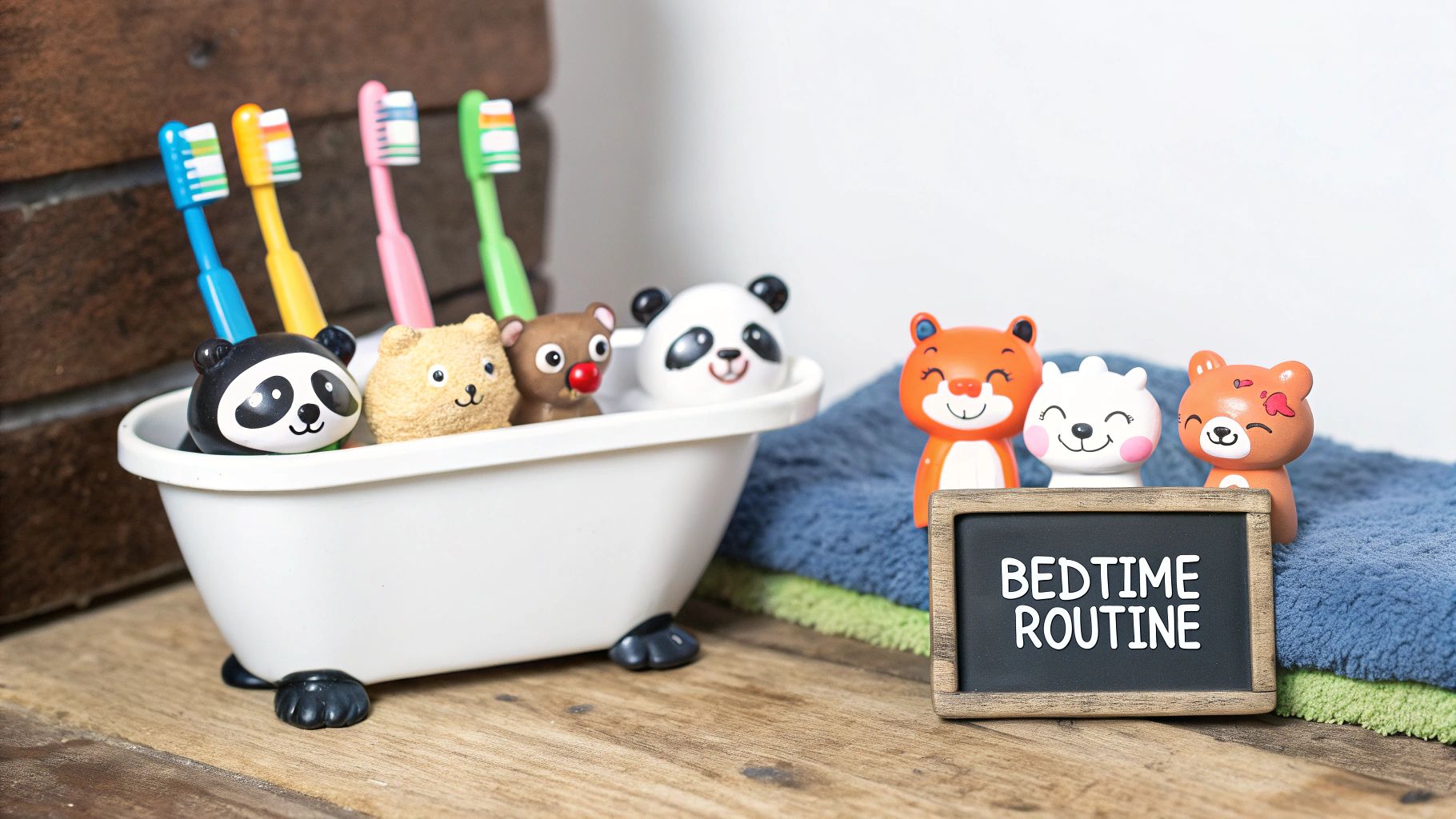
Making the Magic Work for You
Wondering how to leverage this book to conquer bedtime battles? The secret is to make it an active, participatory experience that directly links the story to your child’s real-world actions.
- Act It Out: As you read about the animals brushing their teeth, pause and have your child pretend to brush theirs. When the animals take a bath, talk about their own bath time. This kinesthetic connection makes the routine stick.
- The Routine Checklist: Use the book as a literal guide. Before starting the story, say, "Let's see what the animals do to get ready for bed, just like you!" This frames the routine as a shared, positive experience rather than a list of demands.
- Rhythmic Reading: Read the book with a calm, steady cadence, almost like a lullaby. The predictable rhythm is incredibly soothing and helps regulate a child's breathing and heart rate, preparing their body for sleep.
By turning the bedtime routine into a story, you remove the pressure and replace it with fun and predictability. This empowers your child, giving them a sense of ownership over their own wind-down process.
This book is a fantastic tool for establishing a comforting bedtime sequence, especially for younger kindergartners or those struggling with transitions. By transforming routine tasks into a narrative, you tap into the power of storytelling to make bedtime smoother and more enjoyable for everyone. If you want to explore more ways to make stories a hands-on part of your child's learning, you can discover the benefits of interactive bedtime stories. It's a great way to build on the foundational fun of books like this one.
4. Llama Llama Red Pajama
For the kindergartner wrestling with big feelings at bedtime, Llama Llama Red Pajama by Anna Dewdney is an absolute lifeline. This story masterfully captures that wave of anxiety a child feels when a parent leaves the room—a feeling every parent knows all too well. It validates their fear through Baby Llama's meltdown, providing a safe space to explore emotions like impatience and worry.
The book’s rhythmic, rhyming text mirrors a child's escalating panic and then the calming reassurance that follows when Mama Llama returns. It's one of the best bedtime stories for kindergartners because it doesn't just soothe; it teaches them that their feelings are normal and that a parent's love is constant, even when they're not in sight.

Making the Magic Work for You
Are you struggling to help your child navigate those tricky bedtime fears? This book is more than a story; it's a tool for building emotional resilience. Here's how to maximize its impact.
- Act It Out: Use different tones of voice for Baby Llama's "whimpers," "pouts," and "hollers." When Mama Llama returns, make your voice extra warm and soothing. This vocal performance helps your child connect the sounds with the emotions.
- Pause and Discuss: Before Mama Llama comes back, ask, "How do you think Baby Llama is feeling right now? Is it okay to feel that way?" This opens a dialogue about their own fears without direct pressure.
- The Reassurance Ritual: After the book ends, create your own reassuring phrase. Say something like, "Just like Mama Llama, I am always close by, even if you can't see me. You are safe." Repeat this every night to build a powerful sense of security.
This story directly addresses separation anxiety by showing both the child's distress and the parent's unwavering love. It provides a shared language for you and your child to talk about big emotions that often surface in the quiet of nighttime.
By turning this story into a conversation, you’re not just reading; you’re equipping your child with the tools to understand and manage their own anxiety. For children who thrive on proactive problem-solving, interactive stories can be a game-changer. Apps like Lunesia offer a safe, ad-free world where kids make choices that directly influence a character's journey. Imagine your child helping a character overcome their fear of the dark—they aren't just hearing about courage, they're practicing it.
5. The Runaway Bunny
For the kindergartner wrestling with big feelings about separation, The Runaway Bunny by Margaret Wise Brown is a deeply comforting embrace in book form. This tender story isn't about adventure; it's a powerful dialogue about unconditional love and the unbreakable bond between a parent and child, making it one of the most reassuring bedtime stories for kindergartners.
The story follows a little bunny who tells his mother he will run away, transforming into different things to hide. In response, his mother calmly promises she will become whatever is needed to find and be with him. This gentle, repetitive exchange wraps a child in a blanket of security, proving that a parent's love is a constant, no matter what. It’s frequently used in therapeutic settings for anxious children for this very reason.
Making the Magic Work for You
Wondering how to deepen the story’s powerful message of attachment? The key is to make the mother bunny's steadfast love feel tangible and personal to your child's own life.
- Vocal Dynamics: Use a playful, slightly mischievous voice for the little bunny and a warm, steady, and loving tone for the mother. This contrast highlights the core dynamic: the child’s exploration and the parent’s unwavering presence.
- Pause and Reassure: After the mother bunny explains how she will find her child (e.g., "If you become a fish in a trout stream, I will become a fisherman and I will fish for you"), pause the story. Look at your child and say something like, "Just like that, I will always find you, no matter where you are."
- Discuss the Transformations: Ask your child which transformation they think is the silliest or most clever. This lighthearted engagement reinforces the story’s central theme in a fun, interactive way without diminishing its emotional weight.
This book directly addresses the root of separation anxiety by showing a child that even when they feel distant or want to "run away," their caregiver’s love remains a safe and constant home base.
By focusing on this profound sense of security, you turn a simple book into a therapeutic tool for navigating nighttime fears. You can explore more about how storytelling shapes a child's sense of safety and improves sleep through narrative techniques. It perfectly explains why a story like this is so effective at creating a peaceful state of mind for sleep.
6. Guess How Much I Love You
Sam McBratney’s enchanting tale, Guess How Much I Love You, is a tender dialogue that wraps a child in a blanket of affection before they drift off to sleep. The story follows Little Nutbrown Hare and Big Nutbrown Hare as they sweetly compete to express their boundless love, stretching their arms wide, reaching high, and hopping as far as they can. This gentle back-and-forth isn't just a story; it's a powerful affirmation of the parent-child bond.
The narrative provides a tangible, visual way for kindergartners to understand the vastness of love. As they listen, children feel seen and cherished, making this one of the most reassuring bedtime stories for kindergartners who may be dealing with separation anxiety or nighttime fears. It turns the abstract concept of love into a fun, comforting game.
Making the Magic Work for You
How can you take this heartwarming story and make it an unforgettable part of your nightly routine? The secret is transforming it from a passive listening experience into an active, physical expression of love.
- Act It Out: When Big Nutbrown Hare stretches his arms wide, encourage your child to do the same. When Little Nutbrown Hare hops, do a little hop together on the floor before snuggling back into bed. This physical movement makes the love feel real and tangible.
- A Gentle, Loving Tone: Your voice is the most important tool here. Read with a soft, warm, and loving cadence that mimics the story's gentle rhythm. Let your tone convey the deep affection the characters feel for one another.
- Make It Your Own: After the final page, when Big Nutbrown Hare whispers, "I love you right up to the moon… and back," finish the ritual by whispering to your child how much you love them in your own special way. "I love you more than all the LEGO bricks in the world."
By physically and verbally participating in the story, you are actively strengthening your emotional connection, reinforcing a sense of security that is crucial for a peaceful night's sleep.
This book beautifully builds a child's emotional vocabulary, helping them find words for big feelings. Stories that model healthy emotional expression, like those in the Lunesia app, empower children to understand and communicate their own feelings. In these interactive tales, they don't just hear about love—they make choices based on kindness and empathy, turning storytime into a foundational lesson in emotional intelligence.
7. The Very Hungry Caterpillar
While not a traditional bedtime story, Eric Carle's The Very Hungry Caterpillar is a superstar when it comes to lulling kindergartners to sleep. This beloved classic follows a caterpillar's journey through the days of the week, munching his way toward a beautiful transformation. The story’s gentle, predictable progression provides a perfect rhythm for winding down.
The narrative arc is deeply satisfying for a young mind. It starts small, builds with a playful and repetitive structure, and ends with the peaceful, awe-inspiring emergence of a butterfly. This journey from a tiny egg to a magnificent creature offers a powerful, non-verbal message of growth and positive change, soothing anxieties about the day ending and a new one beginning.
Making the Magic Work for You
Curious how a book about eating can become one of the best bedtime stories for kindergartners? It’s all about focusing the narrative on its calming, cyclical nature and making it an interactive, tactile experience.
- Finger-Tip Exploration: The book’s iconic holes are a brilliant sensory tool. Encourage your child to poke their fingers through the holes as the caterpillar eats. This gentle, repetitive physical action helps them stay engaged but calm.
- Counting and Days: Use the story as a subtle, relaxing recap of concepts they’re learning. Softly count the fruits and name the days of the week, reinforcing their knowledge without the pressure of a formal lesson.
- Focus on the Transformation: As you reach the end, shift your tone to be more hushed and wondrous. Whisper about the caterpillar sleeping in its chrysalis and then use a brighter, gentle voice for the butterfly's arrival. This frames sleep as a restorative, magical process.
By connecting the caterpillar's restful transformation to their own bedtime, you help your child view sleep not as an ending, but as a necessary and wonderful part of growing strong and beautiful.
This story masterfully combines learning with a soothing narrative. The gentle repetition and satisfying conclusion make it an ideal choice for a child who thrives on structure and predictability. It’s a perfect example of how even stories that aren’t explicitly about bedtime can become a cherished part of the nighttime routine.
8. Chicka Chicka Boom Boom
Who says learning the alphabet can't be an energetic party? Chicka Chicka Boom Boom by Bill Martin Jr. and John Archambault is a vibrant, rhythmic adventure that turns letter recognition into a memorable chant. The story follows the letters of the alphabet as they race each other up a coconut tree, creating a lively and unforgettable narrative.
This book is a kindergarten classroom staple for a reason. Its bouncy, predictable rhyme makes it one of the most engaging bedtime stories for kindergartners, especially for those who are just mastering their ABCs. The story’s building tension and eventual "Chicka Chicka… BOOM! BOOM!" climax is pure fun, making learning feel like a game.
Making the Magic Work for You
Wondering how to channel this book’s high energy into a productive part of the bedtime routine? It’s all about timing and turning the story into an interactive performance.
- Rhythmic Reading: Read this book with a strong, percussive rhythm. Tap your hand on the bed or clap gently to the beat of "Chicka Chicka… BOOM! BOOM!" This turns the story into a multisensory experience that aids letter recall.
- Strategic Placement: Because of its energetic nature, this story is perfect for the beginning of your bedtime routine, not the very end. Use it as a fun, final burst of activity before moving on to calmer stories or lullabies.
- Letter Hunt: As you read, encourage your child to point to the letters of their own name or letters they recognize. This interactive element keeps them focused and reinforces their learning in a playful, low-pressure way.
This book brilliantly demonstrates that learning and fun are not mutually exclusive. By associating letters with rhythm and play, you are building a positive foundation for literacy that can last a lifetime.
An engaging, rhythmic story like this activates different parts of a child's brain, much like the interactive adventures in Lunesia. When children actively participate in a story, whether by chanting along or making choices that shape the narrative, their comprehension and engagement skyrocket. This active involvement is key to building confidence and a love for stories.
Top 8 Bedtime Stories Comparison
| Title | 🔄 Implementation Complexity | 💡 Resource Requirements | 📊 Expected Outcomes | ⭐ Key Advantages | ⚡ Ideal Use Cases |
|---|---|---|---|---|---|
| Goodnight Moon | Low – simple text and illustrations | Minimal – requires quiet reading setting | Calming bedtime routine with object recognition | Soothing rhythm and comforting structure | Bedtime for ages 2-6, calming routines |
| Where the Wild Things Are | Medium – rich illustrations and themes | Moderate – requires interaction and discussion | Emotional processing and imagination growth | Addresses childhood emotions, award-winning | Emotional exploration, ages 4-8 |
| The Going to Bed Book | Low – simple repetitive text | Minimal – durable board book format | Reinforces healthy bedtime habits | Durable and interactive, quick reading | Toddlers and young kindergartners (1-5) |
| Llama Llama Red Pajama | Low-Medium – rhyming with emotional depth | Minimal – needs emotional engagement | Helps manage bedtime anxiety | Strong emotional connection and rhymes | Separation anxiety, ages 3-7 |
| The Runaway Bunny | Medium – dialogue and imaginative scenes | Minimal – consistent reading environment | Comfort and security around separation anxiety | Reassuring unconditional love theme | Separation anxiety, ages 3-6 |
| Guess How Much I Love You | Low – gentle dialogue and interaction | Minimal – interactive gestures | Enhances emotional expression and bonding | Engaging love expression, soothing tone | Emotional bonding, ages 2-6 |
| The Very Hungry Caterpillar | Medium – tactile and educational focus | Moderate – interactive pages | Teaches counting, days, and life cycles | Educational plus entertainment | Learning concepts, ages 3-7 |
| Chicka Chicka Boom Boom | Medium – rhythmic, musical text | Minimal – interactive reading encouraged | Alphabet recognition and phonemic awareness | Engaging rhythm, participation focus | Early literacy and phonics, ages 3-6 |
Ready for a Bedtime Revolution? Your Adventure Awaits.
You’ve explored timeless classics and you’re equipped with practical strategies to make storytime a cherished ritual. But what if the journey didn't end with turning the last page? The true revolution in bedtime routines lies in transforming passive listening into active participation, turning your child from a mere spectator into the hero of their own adventure.
The core takeaway from our deep dive into bedtime stories for kindergartners is that stories are more than just a way to wind down. They are powerful tools for shaping character, building resilience, and fostering critical thinking. When you ask your child, "What do you think the runaway bunny will do next?" or "How would you help the Llama Llama feel less scared?", you are laying the foundation for emotional intelligence.
From Listening to Leading: The Next Chapter in Storytelling
Let's recap the most critical insights you can apply tonight:
- Customization is Key: We talked about personalizing stories, like changing a character’s challenge to reflect something your child experienced that day. "Remember when you shared your snack at preschool? That was just like the kind bear in our story." This makes the narrative immediately relevant and deeply engaging.
- Interaction Builds Confidence: Asking "what if" questions doesn't just improve comprehension; it validates their ideas and empowers them to think creatively and solve problems.
- Emotional Connection Over Plot: The magic of classics like Guess How Much I Love You isn't the plot, it's the feeling of security it reinforces. The goal is to connect emotionally, making your child feel safe and understood.
But what if you could take these principles to the next level, without adding more to your already packed schedule? Imagine a world where your kindergartner doesn't just hear about bravery but actively makes courageous choices. Picture them not just being told about kindness but practicing it by helping a story character solve a dilemma.
This is where the Lunesia app becomes your secret weapon. It offers interactive stories where your child makes decisions that shape the adventure. These aren't just bedtime stories—they’re engaging, value-rich journeys that teach kindness, courage, problem-solving, and empathy, all in a safe, ad-free environment. And the bonus for you? While your child is immersed in a meaningful adventure, you gain precious, guilt-free time for yourself, knowing they are learning, growing, and safe. You're not just ending bedtime battles; you're starting a new adventure that nurtures the hero within your child.
Ready to turn storytime into an interactive adventure that builds character and confidence? Discover the world of Lunesia, where your child directs the narrative and learns essential life skills in a safe, ad-free environment. Start your journey with Lunesia today and unlock a new chapter in bedtime routines.
